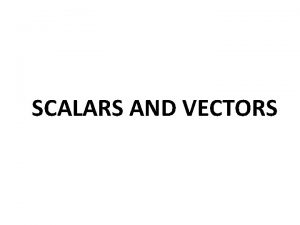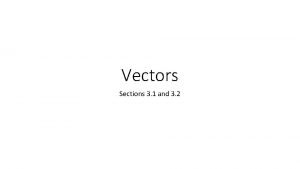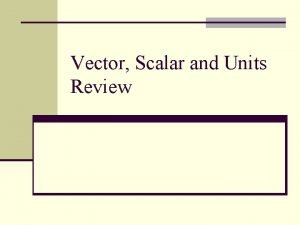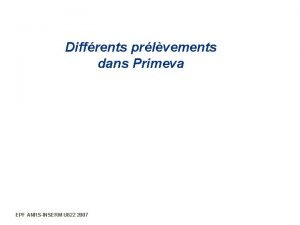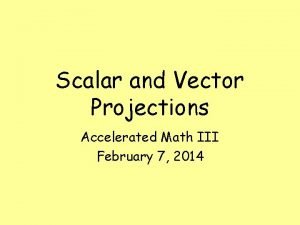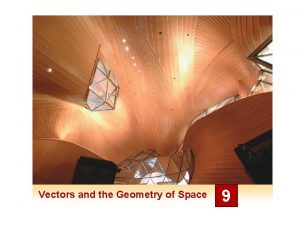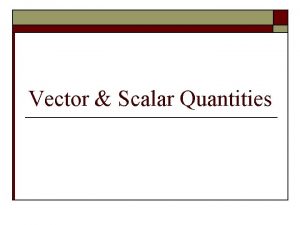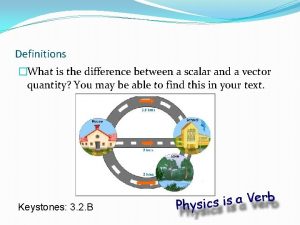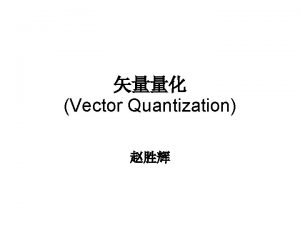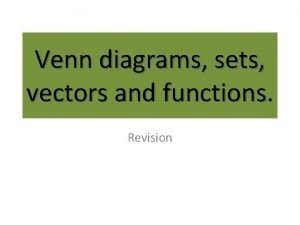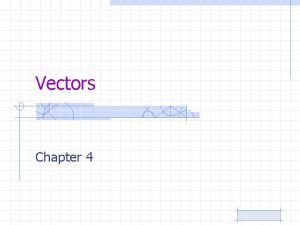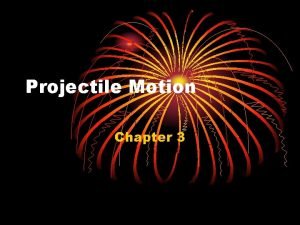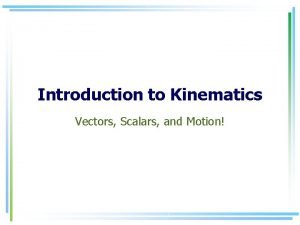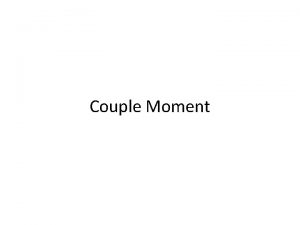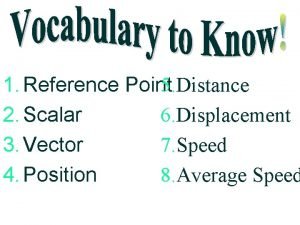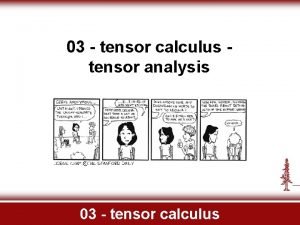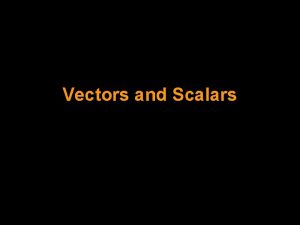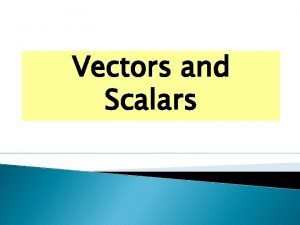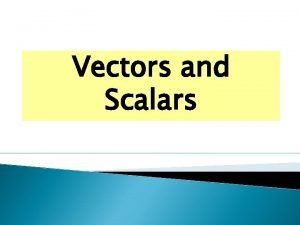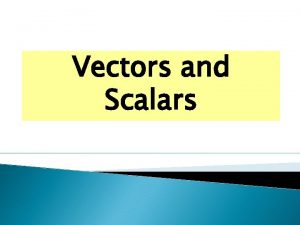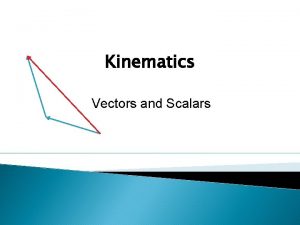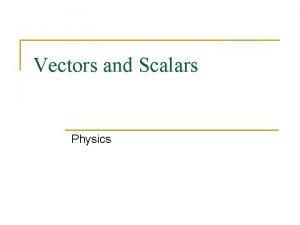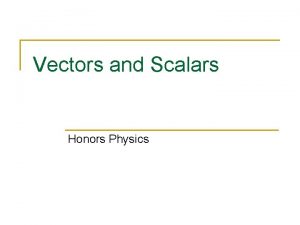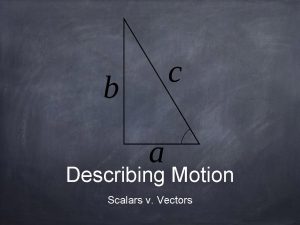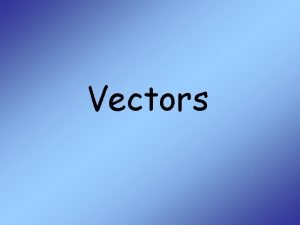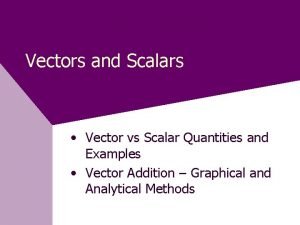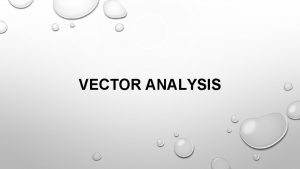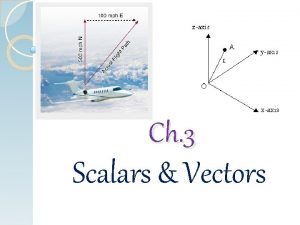Scalars and Vectors 822 Scalar Vector Power Point






























- Slides: 30

Scalars and Vectors

8/22 • Scalar Vector Power. Point • Classwork: Do the Review on page 77 • Homework: Read Ch 3. 1 and check the Review on page 77 from the e. Book • Click ‘Take a Quiz’ at the bottom of p 77 in e. Book. • Email me at coond the Quiz result. Be sure to put your name on it before sending – Print a PDF (Use the Print Function to generate a PDF by changing the printer) of the file and save it to your computer. Attach it to the email coond@leonschools. net

8/23 • Work the 3 A lab using the Investigation 3 A PDF and email me the results • Email me at coond the Quiz result. Be sure to put your name on it before sending – Print a PDF of the file and attach it to the email coond@leonschools. net

Physics terms • vector • scalar • magnitude • coordinates

What is a vector? Some quantities in physics include direction information. Can you name any? ?

What is a vector? Some quantities in physics include direction information. Can you name any? Any variable in which it makes a difference which direction you go, such as forward or backward, must be a vector.

What is a scalar? Other quantities in physics do not require direction information. These quantities are called scalars. Can you name any? Scalars ?

What is a scalar? Mass and temperature are scalars because you don’t need a “direction” to understand what their values mean. Scalars

Coordinates Every point has an x and y value written in the form (x, y). The x and y values are the coordinates of a point relative to the origin (0, 0). What are the coordinates of this point?

Coordinates Every point has an x and y value written in the form (x, y). The x and y values are the coordinates of a point relative to the origin (0, 0). What are the coordinates of this point? (4, 3) because it is +4 along the x-axis and +3 on the y-axis.

Coordinates What is this point?

Coordinates What is this point? (-1, 3) It is -1 along the x-axis and +3 on y-axis. Negative numbers tell you which side of the origin the position is located.

The position vector An object located at this point has a position vector that starts at the origin (0, 0) and ends at (-1, 3).

The position vector Position is a vector. A 2 D surface requires two values to determine a position.

The position vector What would you do if I told you to stand 5 kilometers away?

The position vector What would you do if I told you to stand 5 kilometers away? You should ask where to start and what direction to go. Otherwise you could end up anywhere!

Displacements in 2 D Displacement is a vector since movements need a direction to be fully understood.

Adding displacement vectors What is the final position of a robot that starts from (0, 0) m and makes displacements of: (5, 0) m, (0, 3) m, and (-4, -1) m?

Adding displacement vectors What is the final position of a robot that starts from (0, 0) m and makes displacements of: (5, 0) m, (0, 3) m, and (-4, -1) m? The final position is (1, 2).

Two ways to add vectors The component method of vector addition is the most accurate.

Investigation In Investigation 3 A you will add displacement vectors in a plane. Click the second interactive on page 75.

Assessment 1. Identify each variable listed below as either a vector or a scalar. Are there any variables that are neither vectors nor scalars? a) temperature b) force c) displacement d) length e) velocity f) time

Assessment 1. Identify each variable listed below as either a vector or a scalar. Are there any variables that are neither vectors nor scalars? a) temperature scalar b) force vector c) displacement vector d) length scalar e) velocity vector f) time scalar All variables used in this course are either vectors or scalars.

Assessment 2. A boat travels 5 kilometers east, then 8 kilometers north, and then 8 kilometers west. a) What are the boat’s displacement vectors? b) What is the final position of the boat? c) What distance has the boat traveled? d) What vector will bring the boat back home?

Assessment 2. A boat travels 5 kilometers east, then 8 kilometers north, and then 8 kilometers west. a) What are the boat’s displacement vectors? (5, 0) km, (0, 8) km, (-8, 0) km (0, 8) km (5, 0) km

Assessment 2. A boat travels 5 kilometers east, then 8 kilometers north, and then 8 kilometers west. a) What are the boat’s displacement vectors? (5, 0) km, (0, 8) km, (-8, 0) km b) What is the final position of the boat?

Assessment 2. A boat travels 5 kilometers east, then 8 kilometers north, and then 8 kilometers west. a) What are the boat’s displacement vectors? (5, 0) km, (0, 8) km, (-8, 0) km b) What is the final position of the boat? Add up the displacements: (5 + 0 -8, 0 + 8 +0) = (-3, 8) km

Assessment 2. A boat travels 5 kilometers east, then 8 kilometers north, and then 8 kilometers west. c) What distance has the boat traveled?

Assessment 2. A boat travels 5 kilometers east, then 8 kilometers north, and then 8 kilometers west. c) What distance has the boat traveled? Distance is added from each displacement. Therefore the total distance is: 5 + 8 = 21 km. d) What vector will bring the boat back home?

Assessment 2. A boat travels 5 kilometers east, then 8 kilometers north, and then 8 kilometers west. c) What distance has the boat traveled? Distance is added from each displacement. Therefore the total distance is: 5 + 8 = 21 km. d) What vector will bring the boat back home? The boat’s final position is (-3, 8) km. To get to zero requires a displacement of (3, -8) km because (-3, 8) + (3, -8) = (0, 0)
 Vectors and scalars in physics
Vectors and scalars in physics Difference between vectors and scalars
Difference between vectors and scalars Scalar quantity
Scalar quantity Scalars and vectors
Scalars and vectors Vectors form 3
Vectors form 3 Multiplying or dividing vectors by scalars results in:
Multiplying or dividing vectors by scalars results in: Is time a vector or scalar
Is time a vector or scalar Diffrents
Diffrents Rct-822
Rct-822 Scalar product of vectors
Scalar product of vectors Vector and scalar quantities
Vector and scalar quantities Scalar vs vector projection
Scalar vs vector projection Scalar quantity has
Scalar quantity has Dot
Dot Find the scalar and vector projections of b onto a
Find the scalar and vector projections of b onto a 50 examples of scalar and vector quantities
50 examples of scalar and vector quantities Scalar and vector quantity difference
Scalar and vector quantity difference Scalar vector tensor
Scalar vector tensor Scalar and vector quantization
Scalar and vector quantization Set notation venn diagrams
Set notation venn diagrams Extension of scalars
Extension of scalars Vector vs scalar
Vector vs scalar Scalar vector tensor
Scalar vector tensor Is projectile motion a scalar or vector
Is projectile motion a scalar or vector Angular displacement scalar or vector
Angular displacement scalar or vector Vector quantity
Vector quantity Moment vs couple
Moment vs couple Centripetal acceleration vector
Centripetal acceleration vector Angular displacement is vector or scalar
Angular displacement is vector or scalar Tensor analysis
Tensor analysis Vector vs scalar
Vector vs scalar



